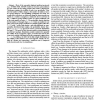Free Online Productivity Tools
i2Speak
i2Symbol
i2OCR
iTex2Img
iWeb2Print
iWeb2Shot
i2Type
iPdf2Split
iPdf2Merge
i2Bopomofo
i2Arabic
i2Style
i2Image
i2PDF
iLatex2Rtf
Sci2ools
INFOCOM
2002
IEEE
2002
IEEE
Stability of a Multicast Tree
— Most of the currently deployed multicast protocols (e.g. DVMRP, PIM, MOSPF) build one shortest path multicast tree per sender, the tree being rooted at the sender’s subnetwork. This paper examines the stability of such a tree, specifically, ”How does the number of links change as the number of multicast users in a group changes?” Two modelling assumptions are made. We assume that (a) packets are delivered along the shortest path tree (which is a realistic assumption as indicated above) and that (b) the m multicast group member nodes are chosen uniformly out of the total number of nodes N. The probability density function for the number of changed edges ∆N (m) when one multicast user joins or leaves the group is studied. For random graphs of the class Gp (N) with N nodes, link density p and with uniformly (or exponentially) distributed link weights, the probability density function Pr [∆N (m) = k] is proved to tend to a Poisson distribution for large N. The proof of this ...
Related Content
| Added | 15 Jul 2010 |
| Updated | 15 Jul 2010 |
| Type | Conference |
| Year | 2002 |
| Where | INFOCOM |
| Authors | Piet Van Mieghem, Milena Janic |
Comments (0)

